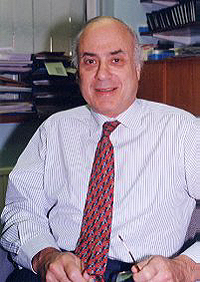 |
|
John
Michael Goldman
|
John Michael Goldman, the pioneer of stem-cell transplantation to treat chronic myelogenous leukemia (CML), is NIH’s newest Fogarty Scholar and will be here for six to nine months between July 1, 2004, and June 30, 2005.
Goldman will be working closely with the NHLBI Hematology Branch, headed by Neal Young, and the Lymphoma and Leukemia Interest Group, chaired by NCI’s Michael Bishop.
Goldman pioneered the use of bone marrow transplantation in the treatment of CML, was the first to use peripheral blood as a source of stem cells for autologous transplant in CML, and published a seminal report in 1986 on the use of allogeneic donors in CML transplant. He was a pioneer in introducing RT-PCR to monitor CML patients after treatment.
More recently, his team carried out some of the first trials of imatinib mesylate (Gleevac) in the treament of CML patients and described leukemias with other chromosomal translocations susceptible to control with this agent. His team is currently using gene profiling and other techniques to explore mechanisms underlying the heterogeneity of CML.
Goldman is chairman of hematology at the Imperial College School of Medicine and the Hammersmith Hospital in London, the director of the Leukaemia Research Fund Centre for Adult Leukaemia, and the medical director of the Anthony Nolan Bone Marrow Trust.
According to Bishop,
who nominated him, Goldman is "a world authority, perhaps the only
world authority, on CML in all its aspects from basic biology to its clinical
management." ![]()
The International Sequencing Consortium has launched a free online resource where scientists and the public can get the latest information on the status of sequencing projects for animal, plant, and other eukaryotic genomes.
The Large-scale Sequencing Project Database can be found at this website and enables searching for sequencing project information by organism, by sequencing group, or by funding agency (such as NHGRI).
Information
about each sequencing project includes timetables for completion and brief
descriptions of the sequencing strategies used. The database also features
links to websites of individual sequencing projects and their funding
agencies, as well as links to other publicly run databases that contain
actual DNA sequence data. ![]()